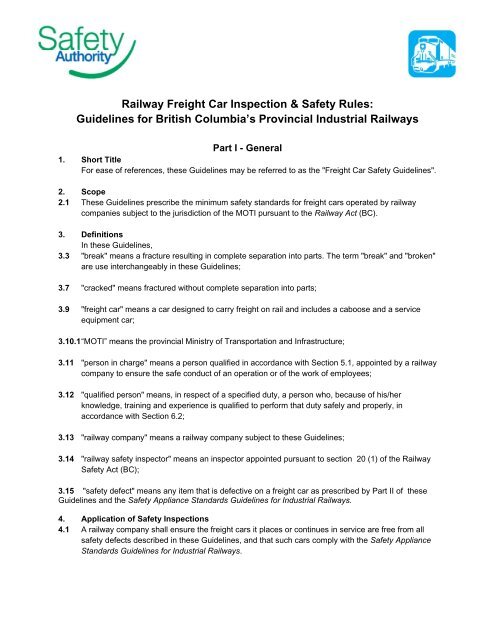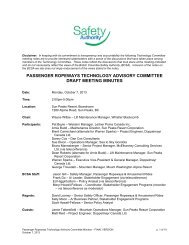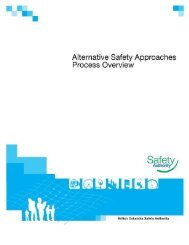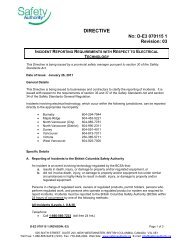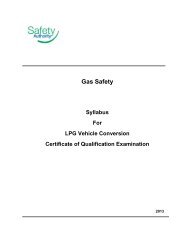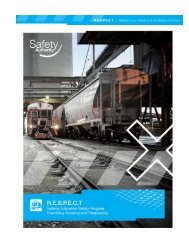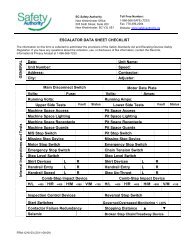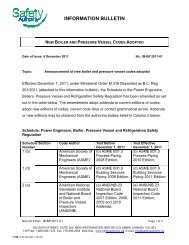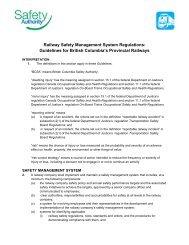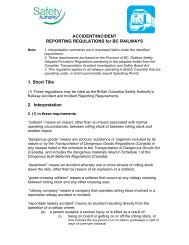Railway Freight Car Inspection & Safety Rules: Guidelines for British ...
Railway Freight Car Inspection & Safety Rules: Guidelines for British ...
Railway Freight Car Inspection & Safety Rules: Guidelines for British ...
You also want an ePaper? Increase the reach of your titles
YUMPU automatically turns print PDFs into web optimized ePapers that Google loves.
<strong>Railway</strong> <strong>Freight</strong> <strong>Car</strong> <strong>Inspection</strong> & <strong>Safety</strong> <strong>Rules</strong>:<strong>Guidelines</strong> <strong>for</strong> <strong>British</strong> Columbia’s Provincial Industrial <strong>Railway</strong>sPart I - General1. Short TitleFor ease of references, these <strong>Guidelines</strong> may be referred to as the "<strong>Freight</strong> <strong>Car</strong> <strong>Safety</strong> <strong>Guidelines</strong>".2. Scope2.1 These <strong>Guidelines</strong> prescribe the minimum safety standards <strong>for</strong> freight cars operated by railwaycompanies subject to the jurisdiction of the MOTI pursuant to the <strong>Railway</strong> Act (BC).3. DefinitionsIn these <strong>Guidelines</strong>,3.3 "break" means a fracture resulting in complete separation into parts. The term "break" and "broken"are use interchangeably in these <strong>Guidelines</strong>;3.7 "cracked" means fractured without complete separation into parts;3.9 "freight car" means a car designed to carry freight on rail and includes a caboose and a serviceequipment car;3.10.1 “MOTI” means the provincial Ministry of Transportation and Infrastructure;3.11 "person in charge" means a person qualified in accordance with Section 5.1, appointed by a railwaycompany to ensure the safe conduct of an operation or of the work of employees;3.12 "qualified person" means, in respect of a specified duty, a person who, because of his/herknowledge, training and experience is qualified to per<strong>for</strong>m that duty safely and properly, inaccordance with Section 6.2;3.13 "railway company" means a railway company subject to these <strong>Guidelines</strong>;3.14 "railway safety inspector" means an inspector appointed pursuant to section 20 (1) of the <strong>Railway</strong><strong>Safety</strong> Act (BC);3.15 "safety defect" means any item that is defective on a freight car as prescribed by Part II of these<strong>Guidelines</strong> and the <strong>Safety</strong> Appliance Standards <strong>Guidelines</strong> <strong>for</strong> Industrial <strong>Railway</strong>s.4. Application of <strong>Safety</strong> <strong>Inspection</strong>s4.1 A railway company shall ensure the freight cars it places or continues in service are free from allsafety defects described in these <strong>Guidelines</strong>, and that such cars comply with the <strong>Safety</strong> ApplianceStandards <strong>Guidelines</strong> <strong>for</strong> Industrial <strong>Railway</strong>s.
4.2 A railway car identified with safety defects may be moved to another location <strong>for</strong> repair includingplacing a loaded car <strong>for</strong> unloading, when authorized by a person in charge, who will ensure that:the car is safe to move;1. a means to protect the car's safe movement is implemented, including identifying <strong>for</strong> theemployees involved the nature of the defects and the2. movement restrictions, if any, and;3. the appropriate records will be retained <strong>for</strong> a period of 60 days.4.3 The movement of a car with safety defects shall be controlled.6. <strong>Safety</strong> <strong>Inspection</strong> Locations6.1 <strong>Safety</strong> inspections shall be per<strong>for</strong>med at locations where cars are added to trains, or wheninterchanged. Such inspections may occur be<strong>for</strong>e or after a car is placed in a train at that location.6.2 A pre-departure inspection of the cars to be added to a train shall be per<strong>for</strong>med by a qualifiedperson, as a minimum, <strong>for</strong> those conditions listed in Appendix 1.7. Requirements <strong>for</strong> dangerous goods cars7.1 Additional inspections of cars carrying goods subject to the "Transportation of Dangerous GoodsAct, 1992" are required as follows:1. Tank cars destined <strong>for</strong> loading with a dangerous good or other cars destined <strong>for</strong> loading ofexplosives shall be given a safety inspection prior to being placed <strong>for</strong> loading.2. <strong>Freight</strong> cars loaded with a dangerous good shall be given an inspection by employees of thereceiving railway, at the point of loading, <strong>for</strong> those conditions listed in Appendix 1.Appendix 1- Pre-departure inspection procedure by other than aqualified car inspectorAt each location where a freight car is to be placed in a train and a certified car inspector is not onduty <strong>for</strong> the purpose of inspecting freight cars, the freight car shall, as a minimum requirement, beinspected <strong>for</strong> these hazardous conditions:1.i. car body leaning or listing to the side;ii. car body sagging downward;iii. car body positioned improperly on the truck;iv. object dragging below the car body;v. object extending from the side of the car body;vi. door insecurely attached;vii. broken or missing safety appliance;viii. lading leaking from a placarded dangerous goods car;2. insecure coupling;3. overheated wheel or journal;4. broken or cracked wheel;5. brake that failed to release; and6. any other apparent safety hazard likely to cause an accident or casualty be<strong>for</strong>e the cararrives at its destination.2


